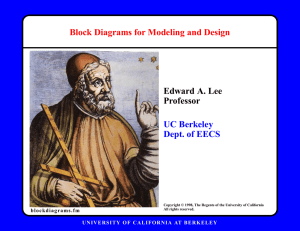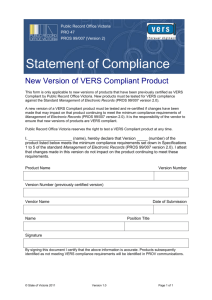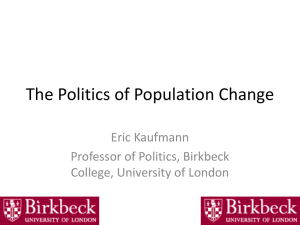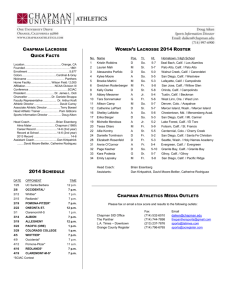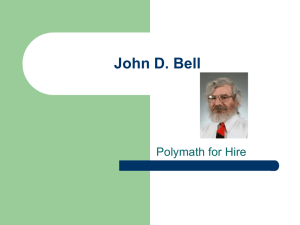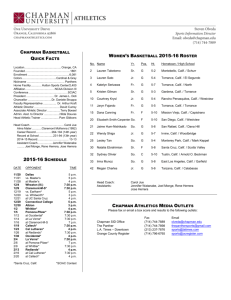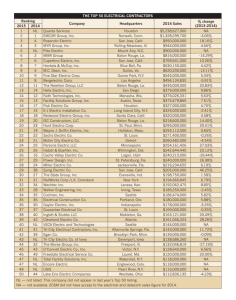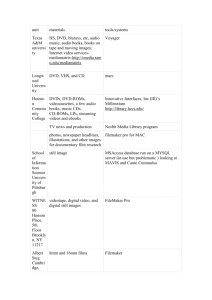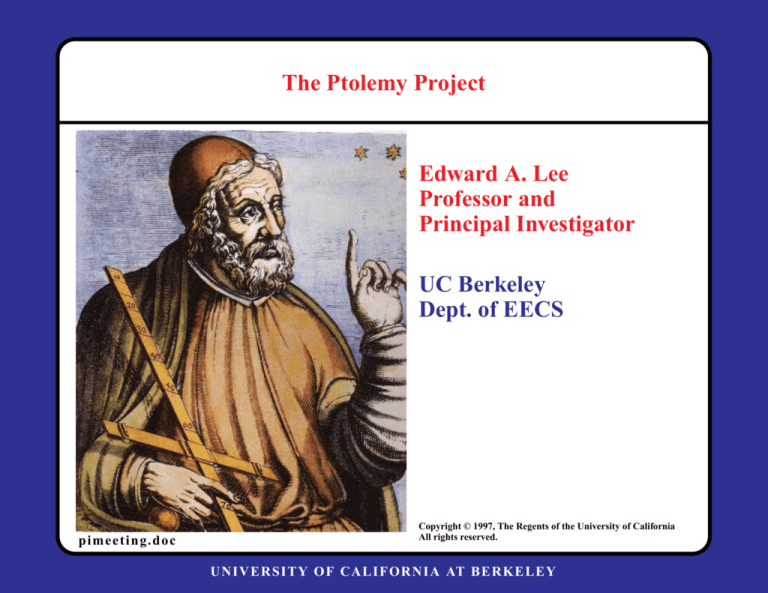
The Ptolemy Project
Edward A. Lee
Professor and
Principal Investigator
UC Berkeley
Dept. of EECS
pi me e t i n g. d o c
Copyright © 1997, The Regents of the University of California
All rights reserved.
U N I VERS ITY OF CALIF ORNIA AT BERKEL E Y
Mission
Ptolemy is a research project and software environment
focused on the design and modeling of reactive systems, providing high-level support for signal processing, communications, and real-time control. The key underlying principle in
the project is the use of multiple models of computation in a
hierarchical heterogeneous design and modeling environment.
pi me e t i n g. d o c
© 1997, p. 2 of 25
U N I VERS ITY OF CALIF ORNIA AT BERKEL E Y
Organizational
Staff
Undergraduate Students
Diane Chang, administrative assistant
Kevin Chang, programmer
Christopher Hylands, programmer analyst
Edward A. Lee, professor and PI
Mary Stewart, programmer analyst
Sunil Bhave
Luis Gutierrez
Key Outside Collaborators
Praveen Murthy
Seehyun Kim
John Reekie
Dick Stevens (on leave from NRL)
Shuvra Bhattacharyya (Hitachi)
Joseph T. Buck (Synopsys)
Brian L. Evans (UT Austin)
Soonhoi Ha (Seoul N. Univ.)
Tom Lane (SSS)
Thomas M. Parks (Lincoln Labs)
José Luis Pino (Hewlett Packard)
Students
Sponsors
Postdocs
Cliff Cordeiro
John Davis
Stephen Edwards
Ron Galicia
Mudit Goel
Michael Goodwin
Bilung Lee
Jie Liu
Michael C. Williamson
Yuhong Xiong
pi me e t i n g. d o c
DARPA
MICRO
The Alta Group of Cadence
Hewlett Packard
Hitachi
Hughes
LG Electronics
NEC
Philips
Rockwell
SRC
© 1997, p. 3 of 25
U N I VERS ITY OF CALIF ORNIA AT BERKEL E Y
Types of Computational Systems
Transformational
• transform a body of input data into a body of output data
Interactive
• interact with the environment at their own speed
Reactive
• react continuously at the speed of the environment
This project focuses on design of reactive systems
• real-time
• embedded
• concurrent
• network-aware
• adaptive
• heterogeneous
pi me e t i n g. d o c
© 1997, p. 4 of 25
U N I VERS ITY OF CALIF ORNIA AT BERKEL E Y
Interactive, High-Level Simulation and Specification
Author: Uwe
Trautwein,
Technical
University of
Ilmenau,
Germany
pi me e t i n g. d o c
© 1997, p. 5 of 25
U N I VERS ITY OF CALIF ORNIA AT BERKEL E Y
Encapsulating Domain-Specific Expertise
Computer Aided Design and Simulation of Free Space Optoelectronic Information
Processing Systems, S.P. Levitan et al., Univ. of Pittsburgh.
pi me e t i n g. d o c
© 1997, p. 6 of 25
U N I VERS ITY OF CALIF ORNIA AT BERKEL E Y
Properties of Such Specifications
• Modular
• Large designs are composed of smaller designs
• Modules encapsulate specialized expertise
• Hierarchical
• Composite designs themselves become modules
• Modules may be very complicated
• Concurrent
• Modules logically operate simultaneously
• Implementations may be sequential or parallel or distributed
• Abstract
• The interaction of modules occurs within a “model of computation”
• Many interesting and useful MoCs have emerged
• Domain Specific
• Expertise encapsulated in MoCs and libraries of modules.
pi me e t i n g. d o c
© 1997, p. 7 of 25
U N I VERS ITY OF CALIF ORNIA AT BERKEL E Y
Heterogeneous Implementation Architectures
network
ASIC
real-time
operating
system
controller
process
user interface
process
microcontroller
system interconnect
microwave,
microfluidic,
MEMS
host port
FPGA
programmable
DSP
CODEC
memory interface
control panel
Heterogeneity is a major source
of complexity in such systems.
DSP
assembly
code
pi me e t i n g. d o c
audio/
video
© 1997, p. 8 of 25
U N I VERS ITY OF CALIF ORNIA AT BERKEL E Y
Two Approaches to the Design of Such Systems
• The grand-unified approach
• Find a common representation language for all components
• Develop techniques to synthesize diverse implementations from this
• The heterogeneous approach
• Find domain-specific models of computation (MoC)
• Hierarchically mix and match MoCs to define a system
• Retargetable synthesis techniques from MoCs to diverse implementations
The Ptolemy project is pursuing the latter approach
• Domain specific MoCs match the applications better
• Choice of MoC can profoundly affect system architecture
• Choice of MoC can limit implementation options
• Synthesis from specialized MoCs is easier than from GULs.
pi me e t i n g. d o c
© 1997, p. 9 of 25
U N I VERS ITY OF CALIF ORNIA AT BERKEL E Y
Heterogeneous System-Level Specification & Modeling
problem level (heterogeneous models of computation)
mapping, synthesis, &
modeling
implementation level (heterogeneous implementation technologies)
pi me e t i n g. d o c
© 1997, p. 10 of 25
U N I VERS ITY OF CALIF ORNIA AT BERKEL E Y
Some Problem-Level Models of Computation
•
•
•
•
•
•
•
•
•
•
•
•
Gears
Differential equations
Difference equations
Discrete-events
Petri nets
Dataflow
Process networks
Actors
Threads
Synchronous/reactive languages
Communicating sequential processes
Hierarchical communicating finite state machines
pi me e t i n g. d o c
© 1997, p. 11 of 25
U N I VERS ITY OF CALIF ORNIA AT BERKEL E Y
Example — Analog Circuit Modeling
A
component
C
waveform
B
voltage or current over time
Strengths:
• Accurate model for many physical systems
• Declarative
• Determinate
Weaknesses:
• Tightly bound to an implementation
• Expensive to simulate
• Difficult to implement in software
pi me e t i n g. d o c
© 1997, p. 12 of 25
U N I VERS ITY OF CALIF ORNIA AT BERKEL E Y
Example — Process Networks
Note: Dataflow is
a special case.
A
process
C
channel
B
stream of tokens
Strengths:
• Good match for signal processing
• Loose synchronization (distributable)
• Determinate
• Maps easily to threads
• Dataflow special cases map well to hardware and embedded software
Weakness:
• Control-intensive systems are hard to specify
pi me e t i n g. d o c
© 1997, p. 13 of 25
U N I VERS ITY OF CALIF ORNIA AT BERKEL E Y
Example — Synchronous/Reactive Models
x
A
module
C
y
signal
B
A discrete model of time
progresses as a sequence of
“ticks.” At a tick, the signals are
defined by a fixed point equation:
z
event
Strengths:
x
y =
z
f A, t ( 1 )
f B, t ( z )
f C , t ( x, y )
• Good match for control-intensive systems
• Tightly synchronized
• Determinate
• Maps well to hardware and software
Weaknesses:
• Computation-intensive systems are overspecified
• Modularity is compromised
pi me e t i n g. d o c
© 1997, p. 14 of 25
U N I VERS ITY OF CALIF ORNIA AT BERKEL E Y
Example — Discrete-Event Models
A
[x1, x2, ...]
[y1, y2, ...]
entities
C
signal
B
[z1, z2, ...]
Events occur at discrete points
on a time line that is usually a
continuum. The entities react to
events in chronological order.
events
Strengths:
• Natural description of digital hardware
• Global synchronization
• Can be made determinate (often is not, however)
Weaknesses:
• Expensive to implement in software
• May over-specify and/or over-model systems (global time)
pi me e t i n g. d o c
© 1997, p. 15 of 25
U N I VERS ITY OF CALIF ORNIA AT BERKEL E Y
Sequential Example — Finite State Machines
A
x/p
y/q
states
C
B
transitions
z/r
Guards determine when a transition may be made from one
state to another, in terms of
events that are visible, and outputs assert other events.
guard/action
Strengths:
• Natural description of sequential control
• Behavior is decidable
• Can be made determinate (often is not, however)
• Good match to hardware or software implementation
Weaknesses:
• Awkward to specify numeric computation
• Size of the state space can get large
pi me e t i n g. d o c
© 1997, p. 16 of 25
U N I VERS ITY OF CALIF ORNIA AT BERKEL E Y
Essential Differences — Models of Time
continuous time
discrete time
Salvador Dali, The Persistence of Memory, 1931
totally-ordered
discrete events
multirate discrete time
E1
E2
E3
E4
F1
F2
F3
F4
G1
G2
G3
G4
⊥
⊥
⊥
⊥
⊥ ⊥ ⊥ ⊥⊥
synchronous/reactive
partially-ordered discrete events
pi me e t i n g. d o c
© 1997, p. 17 of 25
U N I VERS ITY OF CALIF ORNIA AT BERKEL E Y
Key Issues in these Models of Computation
•
•
•
•
•
•
•
•
•
•
•
Maintaining determinacy.
Supporting nondeterminacy.
Bounding the queueing on channels.
Scheduling processes.
Synthesis: mapping to hardware/software implementations.
Providing scalable visual syntaxes.
Resolving circular dependencies.
Modeling causality.
Achieving fast simulations.
Supporting modularity.
Composing multiple models of computation.
pi me e t i n g. d o c
© 1997, p. 18 of 25
U N I VERS ITY OF CALIF ORNIA AT BERKEL E Y
History of the Ptolemy Project
• 1990 — started with seed support from DARPA VLSI
program. Focus on embedded DSP software and
communication networks.
• 1993 — joined DARPA RASSP program. Focus on highthroughput embedded real-time signal processing systems.
• 1995 — The Alta Group at Cadence announces software
using Ptolemy dataflow and mixed dataflow/discrete-event
technology (SPW).
• 1997 — joined DARPA Composite CAD program. Focus on
distributed adaptive reactive systems with mixed
implementation technologies and modeling techniques.
• 1997 — Hewlett-Packard (EEsof) announces “HP Ptolemy,”
an integration of Ptolemy dataflow technology with analog
RF and microwave design and modeling tools.
pi me e t i n g. d o c
© 1997, p. 19 of 25
U N I VERS ITY OF CALIF ORNIA AT BERKEL E Y
Our Contributions to Dataflow Modeling
— the most mature parts of Ptolemy —
• Compile-time scheduling of synchronous dataflow graphs
with optimized partitioning and memory utilization.
• Specification of the Boolean dataflow (BDF) model, which is
Turing complete.
• Proof that the existence of a finite complete cycle and a
bounded memory implementation for BDF is undecidable.
• Heuristics for constructing finite complete cycles and
bounded memory schedules most of the time.
• Multidimensional generalization to dataflow models.
• Process network model generalization to dataflow.
• Visual programming formulation and use of higher-order
functions.
pi me e t i n g. d o c
© 1997, p. 20 of 25
U N I VERS ITY OF CALIF ORNIA AT BERKEL E Y
Composite CAD Project
Phase 1 (11/96 — 5/98)
• Modular deployable design tools
• Domain-specific tools emphasizing control and signal proc.
• Models for dynamically configured systems
Phase 2 (6/98 — 11/99)
• Process-level types for managing heterogeneity
• Formal analysis and computer-aided debugging
• System-level visualization with heterogeneous syntaxes
Option (4/97 — 12/97)
• Array formalism for multidimensional signal processing
pi me e t i n g. d o c
© 1997, p. 21 of 25
U N I VERS ITY OF CALIF ORNIA AT BERKEL E Y
Progress: Generalized Hybrid Systems — *Charts
Choice of domain here determines concurrent semantics
FSM
FSM
Hierarchy is free
pi me e t i n g. d o c
© 1997, p. 22 of 25
U N I VERS ITY OF CALIF ORNIA AT BERKEL E Y
Near Term Software Strategy
— Java plus Itcl —
•
•
•
•
•
Object-oriented.
Systems programming plus scripting.
Network-aware design tools.
Deployable tool packages.
Sophisticated heterogeneous visualization.
pi me e t i n g. d o c
© 1997, p. 23 of 25
U N I VERS ITY OF CALIF ORNIA AT BERKEL E Y
Ptolemy Software as a Tool and as a Laboratory
Ptolemy software is
• Extensible
• Publicly available
• An open architecture
• Object-oriented
Allows for experiments with:
• Models of computation
• Heterogeneous design
• Domain-specific tools
• Design methodology
• Software synthesis
• Hardware synthesis
• Cosimulation
• Cosynthesis
• Visual syntaxes (Tycho)
pi me e t i n g. d o c
© 1997, p. 24 of 25
U N I VERS ITY OF CALIF ORNIA AT BERKEL E Y
Further Information
•
•
•
•
•
•
•
•
•
•
•
•
Software distributions
Small demonstration versions
Project overview
The Almagest (software manual)
Current projects summary
Project publications
Keyword searching
Project participants
Sponsors
Copy of the FAQ
Newsgroup info
Mailing lists info
http://ptolemy.eecs.berkeley.edu
pi me e t i n g. d o c
© 1997, p. 25 of 25
U N I VERS ITY OF CALIF ORNIA AT BERKEL E Y

